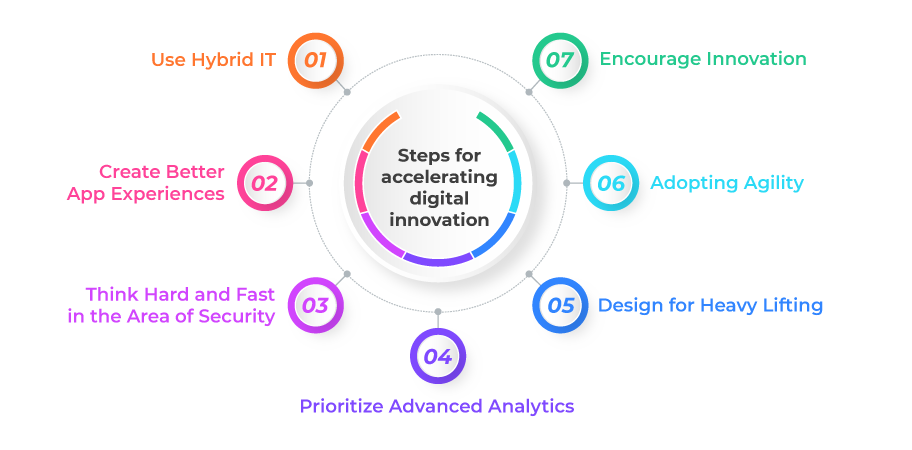
This article was first published on ITProPortal
The time is truly here, looking to accelerate one more process in our lives; this time, we are looking to accelerate digital innovation. We are no longer a part of the digital era and have moved into the post-digital era. Almost every organization is moving to an entirely digital setup due to the fact success is based on the ability to have great digital competencies in place. This need to bring about change and deliver personalized experiences requires a new kind of system that allows their immediate creation. This is what is bringing businesses towards asking the question, “how to accelerate digital innovation.”
We are in a digital space, and having IT set up new applications is not enough. So, in this article, we will dive into what digital innovation is, why digital innovation is important, and what technology trends are that can help you and your business achieve post-digital success.
What is Digital Innovation?
Every industry today is in a position to benefit from digital tools. The nature of work has changed, and it is digital. At the core of it all, digital innovation is the way to go, and all we can do is accelerate digital innovation to improve existing business processes, efficiency, and business models.
What is the importance of Accelerating Digital Innovation?
Be it work consumption or digital consumption. There is always a digital component. Studies have shown that 89% of all organizations are in the process of adopting an all-digital business plan. This means digital innovation trends and technology will be at the forefront. On the other hand. It has also been seen that companies that are not truly embracing the digital future are falling behind and running the risk of becoming obsolete.
For example, let’s look at Kodak. They discounted the force of the digital transformation that smartphones would bring about and lost out on a huge chunk of the photography business. Things are quite clear, and there is a problem if we don’t see it. The world’s largest taxi service owns no cars, and mobile applications can be built in a matter of a few days. It is a world of disrupting or being disrupted.
Differences between Digital Innovation and Digital Transformation and the need to Accelerate in this space
Digital Transformation
Digital transformation is the continuous process in which a business is transformed and improved by changing its method of operations. This is not only about technology adoption but also the mechanisms that run it, the people of the organization, and the way all this shaped the portfolio of the organization as a whole. Accelerating digital innovation would be more on the lines of the whole business than anything else.
Also read: Digital Transformation Demystified !!
Digital Innovation
Digital innovation, on the other hand, is the creation and/or development of new technology that will help a business or a group of people. Digital Innovation looks at taking and making the most of existing technological tools, almost as a precursor to digital transformation. Accelerating digital innovation means setting the foundation to accelerate digital transformation.
Supporting and Accelerating Digital Innovation in a Business Setting
Low code and no code software are at the forefront of this move to accelerate digital innovation. An advanced no-code platform like Quixy can facilitate application development, even by non-technical professionals, in a matter of a few hours. Such applications act as the catalyst for businesses to take bigger steps in digital directions.

1. Use Hybrid IT
Traditional IT cannot be replaced by no-code and low-code overnight, or for that matter, potentially ever, but they can coexist and help one another. Every environment in an organization is connected by IT, and the hybridization of that function should allow all these minds to think to accelerate digital innovation and transformation.
2. Create Better App Experiences
With thousands and thousands of applications that exist to solve every problem known to mankind, it is important that the ones you create, even if they are for organizational use only, are customized. People are looking for immediate solutions to their problems, and they want them to be easy and accessible. Understand the activity and use that to create transformed digital experiences.
3. Think Hard and Fast in the Area of Security
Digital innovation and transformation lead to huge potential to change the trajectory of a business, but like every great idea, it comes with a set of its own risks. While implementing intra and inter-business digital innovation, workflows, and roadmaps must be set in place to ensure data and personnel security. Remember to pay heed to new situations and choose software that has systems in place to combat such problems.
4. Prioritize Advanced Analytics
The ultimate goal of a business is to maximize profits while minimizing efforts. Digital innovations, especially through no-code and low-code, make a lot of space for that. Therefore, while enabling and accelerating digital innovations, ground rules must be set in place to honor existing business processes and only change them where the data suggests there is room for improvement. You want to ensure your analytical model is satisfied by the steps you are taking to change the functioning of your business.
5. Design for Heavy Lifting
Creating a value-adding system will enable organizations to determine the projects that will have a higher impact on the organization, both long-term and short-term. For example, if two business functions in your business work closely, innovate software that overlaps between the two functions and allows both to work faster together. There is no point in designing pretty software that only serves one small purpose. Digital innovation might seem expensive at first, but organizations must keep investing in new and higher ROI projects for real benefits in the long run.
6. Adopting Agility
Today’s ever-evolving marketplace demands a quick response to change. While digital innovation aids in achieving that, the only thing that ensures smoother sailing on that path is the ability to adapt to changes. The agile business model enables the organization to inculcate these changes while also remaining flexible to the current business conditions.
7. Encourage Innovation
Workplace no longer is equally about the work and the place, today, it is all about the work and the place no longer matters. However, in most situations, people work better if they are in the same place and sharing ideas. While this may not be possible physically, always look to remind employees that innovation is encouraged and that productivity will be rewarded. This also becomes a great way to cultivate comradery and integrate new employees.

Why is This Relevant to My Business?
Gartner predicts that by the year 2025, all industries will be completely transformed by digital. And, as we have stated, the root of transformation is innovation. In the simplest of words, you must accelerate innovation in your organization to ensure you are not left behind.
Gartner predicts that by the year 2025, all industries will be completely transformed by digital.
Digital innovation is a silent forerunner in changing how business works in today’s day and age, and we have your back to become a part of all this change. Get Started Today! Empower your organization with automation and customized app development without coding.
Frequently Asked Questions(FAQs)
What is meant by digital innovation?
Digital innovation involves leveraging technology to create new or improved products, services, processes, or business models. It encompasses the application of digital technologies to drive positive changes and enhance efficiency.
What is an example of digital innovation?
An example of digital innovation is the introduction of contactless payment systems in the banking industry. It transformed traditional payment methods, offering a faster and more convenient way for customers to make transactions.
What is the use of digital innovation?
Digital innovation is used to solve problems, enhance efficiency, and capitalize on opportunities. It can lead to improved customer experiences, streamlined processes, and increased competitiveness in the digital era.
What is the difference between innovation and digital innovation?
While innovation is a broad concept encompassing any novel idea or improvement, digital innovation specifically involves the application of digital technologies like AI, IoT, and data analytics to drive advancements in various domains.
What are the four stages of digital innovation?
Discovery: Identifying opportunities and challenges that can be addressed through digital innovation.
Design: Planning and conceptualizing digital solutions to meet the identified needs.
Delivery: Implementing and launching digital innovation, often involving development and deployment.
Data-Driven Improvement: Continuously refining and optimizing the digital innovation based on feedback and data analysis.
Login
Please login to comment
0 Comments
Oldest















